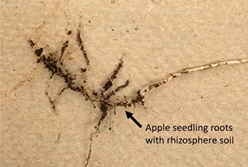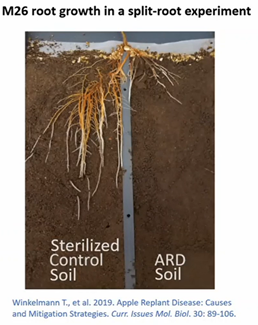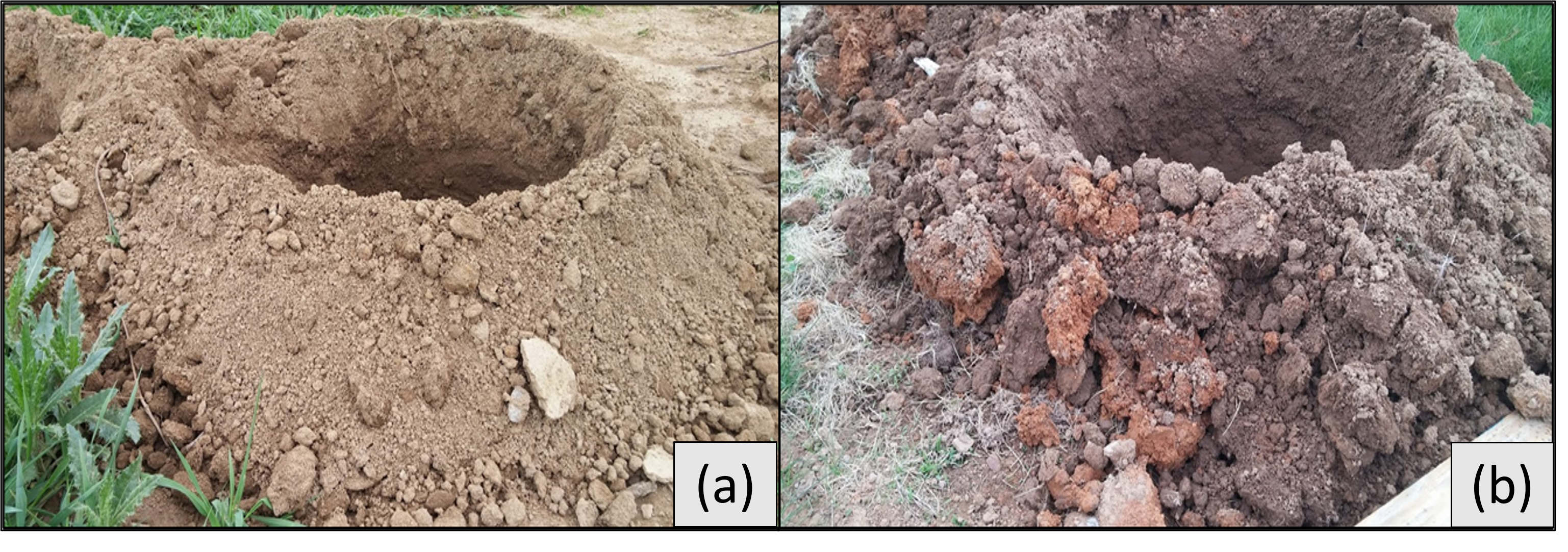Apple replant disease and soil health assessments: A follow-up from the International Tree Fruit Association annual conference
A summary of apple replant disease and bio-renovation strategies for disease management.

Additional topics discussed at the International Tree Fruit Association 65th annual conference included orchard establishment, orchard replant, soil health and cover cropping. Researchers Tracey Somera, USDA research molecular biologist, and Tianna DuPont, Washington State University (WSU) tree fruit Extension specialist, as well as a grower panel discussed strategies for orchard site evaluation and tips for tree establishment and orchard success.
Here we’ll highlight topics related to replant disease and soil health assessments.
Replant disease — what is it?
Replant disease is a concern in fruit and nut production locations, which can occur when establishing the same or related species on an old orchard site (replant site). This disease is marked by poor growth of young trees, and it commonly affects nut crops, stone fruit and pome fruit.
Apple replant disease (ARD) is a disease complex that has been found in major apple growing regions around the world. Apple replant disease is caused by a complex of biological agents including the root lesion nematode (Pratylenchus spp.) and multiple root-associated fungal and oomycete pathogens such as Rhizoctonia solani, Ilyonectria/Cylindrocarpon, Pythium and Phytophthora. Pathogen overwintering structures and spores can last in the soil and dead or dormant roots for many years. In addition, lesion nematodes survive as eggs, juveniles and adults in soil and plant material. If left untreated, the effects of ARD can result is significant economic losses in apple production with an estimated $70,000 to $150,000 in reduced returns.
Effective chemical management strategies use soil fumigation with 1,3-Dichloropropene plus Chloropicrin, Metam Sodium (or Metam Potassium) and Dazomet (a Methyl isothiocyanate product). This is a common practice in many apple production regions, such as Washington, but also has a significant detrimental impact on soil health and typically uses materials toxic to human health.
Cultural management strategies include planting nematode-free trees, rotating crops before replanting with apple, ensuring adequate soil drainage, improving soil structure, planting new trees in old inter-row grass plantings, and selecting tolerant rootstocks.
Research on ARD in Washington
Researchers in Washington at the USDA and WSU continue to study ARD, including differences in rootstocks and their tolerance to ARD and alternative fumigation strategies using biofumigants. Somera et al., 2021 investigated how apple rootstocks respond to ARD affected soils. Some rootstocks, such as G.935, G.890 and G.210 are more tolerant to ARD than M.26 and M.9. Somera is working to understand why some rootstocks can tolerate ARD more than others.

For example, some rootstocks may tolerate ARD by quickly shedding infected roots and growing new ones. This is the case for G.210, but not all rootstocks regrow roots so quickly. Another mechanism of protection against ARD pathogen infection may be through the roots and the rhizosphere. The rhizosphere is the thin layer of soil that adheres to the surface of the root. It is affected by the growth and functions of the root and supports many kinds of bacterial and fungi that make up root-associated microbial communities. The microbial communities found in the rhizosphere may also support beneficial fungi and bacteria that protect apple roots against ARD associated pathogens.
What factors influence microbial communities and their effect on pathogenic organisms? Somera compared apple rootstocks that were tolerant or susceptible to ARD. She reported that some rootstocks produce different metabolic compounds called root exudates, which include compounds such as amino acids, organic acids, sugars and phenolics. One compound that was identified in the ARD tolerant rootstock, G.935, was benzoic acid. Benzoic acid has been shown to inhibit growth of soil microbes and may inhibit growth of ARD pathogens.
In addition to microbial communities in the soil and rhizosphere, different rootstocks support different microbial communities living in the plant, such as endophytes and beneficial mycorrhizal fungi. Endophytes are fungi or bacteria that live inside the plant but do not affect the health or growth of the plant. Mycorrhizal fungi are beneficial fungi and colonize plant root cells. Mycorrhizal fungi send filamentous hyphae into the soil around the root to take up nutrients. Then those nutrients are transferred to the root cell in exchange for energy in the form of carbohydrates. Roots colonized by mycorrhizal fungi are associated with less colonization by non-mycorrhizal fungi and potential pathogens. In studies conducted at WSU, the ARD tolerant rootstock, G.890, had the highest colonization by mycorrhizal fungi. Also, once mycorrhizal fungi were established in the root, they tended to stay.
Research is ongoing to look at how different rootstocks respond to ARD in different environments either through root system traits or through plant-microbe mechanisms of protection. Since ARD pathogens are common across disease locations, Somera wants to know if rootstock tolerance is also similar in different locations. She will be studying gene expression for rootstocks to identify genes that are correlated with ARD tolerance. She will also be evaluating which rootstocks are able to quickly shed and regrow roots or support specific beneficial bacteria and fungi that protect against ARD pathogen infection.
Assessing soil at replant sites and options for remediation
In addition, Tianna Dupont spoke about the importance of soil health and soil factors that affect growth of fruit trees. A recording of her presentations on soil health in orchards from the WSU virtual workshops is available on the WSU website. She conducted a study of 101 sites in Central Washington to identify soil health indicators that were related to poor soil health and limited fruit yield and quality. Soil health is the ability of a soil to continually support and sustain plants and soil microbes, minimize erosion, regulate water flow, and buffer and filter potentially toxic materials.

For crop production, key soil health functions that support plant growth are related to root health, water and nutrient availability, and protection against soil-borne pathogens. Twenty-one soil health indicators were evaluated in Central Washington orchards by Dupont. Factors that had the greatest effect on yield and fruit quality were available water capacity, soil compaction, nematode populations and the presence of apple replant pathogens.
Options for mitigating replant risks continue to be evaluated. When replanting an orchard, Dupont recommends removing as many roots as possible and using deep tillage to break up compacted soil. While chemical fumigation is standard practice, three remedial practices are being investigated in Washington.
One practice is bio-renovation using brassica or mustard seed meals. Mustard seed meals produce volatile compounds such as glucosinolate that suppress soil-borne pathogens. This practice uses meal from white or brown mustard and is applied the fall before planting in August when soil temperatures are around 70-80 degrees Fahrenheit. Once ground is tilled, mustard should be spread in the new tree rows (3-5 tons per acre). Within 30 minutes of seed meal application, a tarp made of total impermeable film (TIF) should be laid over the seed meal. To complete the treatment, the tarp should remain over the seed meal treatment for two to three weeks. Then the tarp can be removed to let the fumigant dissipate.
A second practice is call anaerobic soil disinfestation (ASD), which is a process where anaerobic (without) microbes decompose plant material and release volatile compounds that are toxic to soil-borne pathogens and plant parasites. The goal of this practice is to shift the microbial community and suppress soil-borne pathogens.
For ASD, plant material (carbon source) is chopped into small pieces and incorporated into the soil. Plant materials that have been used in Washington are triticale (terminated at anthesis, 10 tons per acre) and timothy hay (8 tons per acre). Then the soil should be flooded using a double line of drip tape and kept very wet (30% volumetric water content) during treatment. Finally, the plant material should be covered with a gas impermeable plastic film for three weeks.
A third practice to remediate soil is bio-renovation using cover crops. Dupont recommended using sorghum-sudangrass and canola. Cover crops can be used to suppress nematodes and soil-borne pathogens as well as improve soil health. For example, when canola is incorporated into the soil, it releases isothiocyanates, which are toxic to soil-borne pests and pathogens. Cover crops can be used in rotations for two or more years after an orchard has been removed and before a new orchard is planted. Cover crops should be fertilized adequately to get the most benefit and increase biomass production. When the cover crop is about 18 inches, Dupont recommended a first mowing and an addition of ammonium sulfate. Plant material can then be chopped and incorporated into the soil.
In addition, other sources of organic matter can benefit soil by minimizing erosion, enhancing water infiltration, moderating soil temperature, building soil structure and increasing nutrient availability and organic matter. Additions of materials such as wood chip-type mulch at 3-4 inches deep, compost, light mulching from orchard mowing that is blown into the tree row, and some humic products support healthy soils.

In conjunction with soil health, it’s also important to note that maintaining availability of plant-based material in the field provides a constant food source for creatures that are part of the soil food web such as microbes and arthropods. As some of these practices are not as effective at managing ARD as chemical fumigants, further research is needed to better understand how to support healthy soils and mitigate effects of ARD-associated pathogens.



 Print
Print Email
Email


